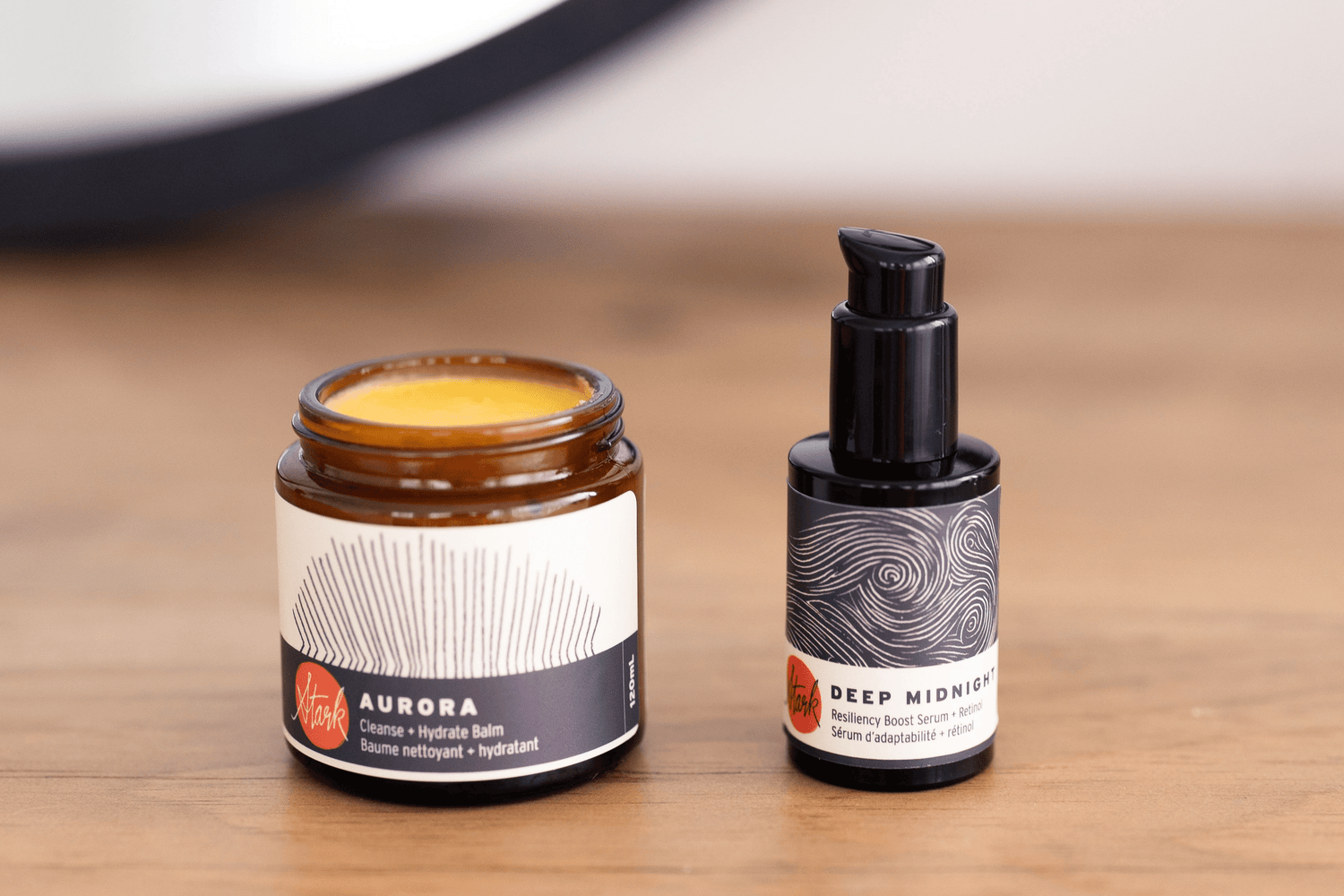
Your Office Is Quietly Undermining Your Skincare Routine
Partager
Your morning skincare routine isn't failing you. The problem is what happens between 9 AM and 5 PM.
While you apply antioxidant serums and protective creams, your office environment contains pollutant levels that would genuinely surprise you. The EPA documents that volatile organic compounds in office buildings regularly measure 2 to 5 times higher than outdoor levels, sometimes reaching 10 times higher during certain activities.
Cleaning products, office furniture, carpeting, and that seemingly innocent photocopier are releasing compounds that challenge your skin in ways your skincare routine was never designed to address. Add poor ventilation, recirculated air, and the fact that Americans spend approximately 90% of their time indoors, and you have conditions affecting your skin for eight hours daily.
This isn't about creating workplace anxiety—it's about understanding how indoor environmental factors shape skin health so you can make intelligent adaptations. Once you see what's happening in that climate-controlled workspace, environmental skincare starts making complete sense.
What Research Shows About Indoor Air Quality
Your office air isn't neutral. It's actively presenting your skin with environmental challenges that most skincare approaches don't consider. The Environmental Protection Agency's studies reveal something significant: creating "controlled" indoor environments often concentrates pollutants rather than eliminating them.
The concentration effect: Research consistently shows that indoor air contains higher levels of volatile organic compounds (VOCs) than outdoor air, even in polluted urban areas. These compounds come from furniture, carpeting, cleaning products, office equipment, and building materials, creating a low-level chemical environment that your skin encounters for eight hours daily.
The ventilation challenge: Many modern office buildings use recirculated air systems that, while energy-efficient, concentrate airborne compounds rather than removing them. The Occupational Safety and Health Administration recognizes this as significant enough to include indoor air quality in workplace safety guidelines.
The invisible exposure: Unlike outdoor pollution, which we can see, smell, or anticipate, indoor air quality issues are largely invisible. You experience the effects—fatigue, headaches, eye irritation—without connecting them to environmental factors that are also affecting your skin.
Discover how adaptive barrier protection works with your skin's natural intelligence
How Indoor Environmental Stress Affects Your Skin
The relationship between indoor air quality and health is well-established. The skin implications are becoming clearer as research on air pollution and skin health provides insights into how environmental factors affect your largest organ.
Volatile organic compound exposure: Office environments contain measurable levels of formaldehyde, toluene, benzene, and other VOCs from furniture, carpeting, cleaning products, and office equipment. Studies show these compounds cause eye and respiratory irritation, headaches, and fatigue—symptoms indicating your body's protective systems are working overtime.
The sick building syndrome connection: The EPA recognizes sick building syndrome as a legitimate health concern affecting office workers. Symptoms include fatigue, headache, eye irritation, and difficulty concentrating. These are signs that environmental stressors are challenging your body's adaptive systems, including your skin's protective functions.
Oxidative stress accumulation: Research on air pollution and skin health demonstrates that environmental pollutants generate reactive oxygen species and inflammatory responses in skin cells. While most studies focus on outdoor pollution, the principle applies to any environment where chemical compounds challenge your skin's natural protective mechanisms.
What This Means for Your Skin
The documented effects of poor indoor air quality—fatigue, irritation, compromised immune function—suggest that your skin is also working harder to maintain its protective barriers in office environments.
Environmental adaptation exhaustion: Spending eight hours daily in an environment with elevated pollutant levels requires constant adaptation from your skin's protective systems. This ongoing low-level stress compromises your skin's ability to handle other environmental challenges effectively.
Barrier function demands: Research shows that environmental stressors disrupt skin barrier function. In office environments with elevated VOC levels and poor air circulation, your skin works overtime to maintain protective integrity while managing other daily environmental exposures.
The cumulative effect: Unlike acute environmental exposure, office air quality represents chronic, low-level environmental stress. Occupational health experts increasingly recognize the health impacts of this exposure pattern as significant factors in overall wellbeing.
The Productivity Connection
OSHA estimates that poor indoor air quality costs the nation tens of billions of dollars annually in lost productivity and medical care, suggesting that the effects of office environments on human health are both measurable and significant.
Cognitive impact research: Studies show that elevated CO2 levels, common in poorly ventilated offices, significantly affect cognitive function and decision-making ability. If your brain function is being affected, your skin's complex adaptive functions are likely also being challenged. The skin and brain share a close relationship.
The inflammation connection: Research consistently links environmental stressors to inflammatory responses throughout the body. Chronic low-level inflammation from environmental exposure compromises skin health, barrier function, and natural repair processes.
Stress amplification: Poor environmental conditions create physiological stress that elevates cortisol levels, which directly impairs skin barrier function and compromises your skin's ability to adapt to environmental challenges.
The Evolutionary Mismatch
Human skin evolved to thrive in dynamic natural environments with variable conditions and natural air circulation. The modern office represents a unique evolutionary challenge: an artificially controlled environment that paradoxically concentrates environmental stressors.
The adaptation challenge: Your skin's protective mechanisms are designed to respond to natural environmental variability. Spending most waking hours in environments with consistently elevated pollutant levels and poor air circulation creates an adaptation challenge that didn't exist in human evolutionary history.
Natural vs. artificial environmental stress: While your skin has sophisticated mechanisms for handling natural environmental challenges—UV exposure, temperature changes, seasonal variations—it's less prepared for the specific combination of chemical exposures and poor air quality that characterize modern indoor environments.
This mismatch explains why many office workers experience skin sensitivity, fatigue, and other health issues despite working in apparently "controlled" environments. The control often concentrates rather than eliminates environmental challenges.
Official Recognition
The connection between indoor environments and health is increasingly recognized by major health organizations:
EPA acknowledgment: The Environmental Protection Agency specifically identifies indoor air quality as a major environmental health concern, noting that pollutant levels indoors often exceed outdoor levels even in urban areas.
OSHA workplace standards: The Occupational Safety and Health Administration includes indoor air quality in workplace safety guidelines, recognizing that environmental conditions in offices significantly impact worker health and productivity.
CDC recommendations: The Centers for Disease Control provides specific guidance for improving indoor air quality in workplaces, acknowledging that environmental factors in office buildings create legitimate health concerns.
This institutional recognition suggests that office environmental effects on health—including skin health—are legitimate concerns backed by substantial research rather than speculative worries.

Environmental Intelligence for Office Workers
Understanding how office environments affect your health opens possibilities for intelligent adaptations that go beyond traditional skincare:
Environmental awareness: Recognizing that your office environment presents specific challenges allows you to make informed decisions about protection strategies, just as you would for any other environmental exposure.
Timing strategies: Applying protective skincare specifically for office exposure—rather than following generic routines—acknowledges the reality of your actual environmental conditions.
Recovery protocols: Developing evening routines that help your skin recover from daily environmental exposure while building resilience for ongoing challenges. Plus, it's genuinely relaxing.
Microenvironment optimization: Making small environmental modifications where possible—desk plants, air purifiers, positioning relative to windows—that support rather than challenge your skin's adaptive capacity.
The Broader Environmental Picture
The office environment represents just one aspect of the complex environmental challenges facing modern skin health. However, it's significant because it's where many people spend the majority of their waking hours.
The home office advantage: Remote work often provides better air quality, natural light exposure, and environmental variability—conditions that support rather than challenge skin health. Many people notice improved skin when working from home, which may reflect reduced environmental stress.
The hybrid opportunity: Alternating between different environments provides the variability that skin health thrives on, rather than the static conditions that can deplete adaptive capacity over time.
This shift in work patterns creates new awareness about how profoundly our work environments shape our health, including skin health.
Building Environmental Resilience
Recognizing office environmental effects isn't about avoiding modern work life—it's about developing environmental intelligence that helps your skin adapt and thrive regardless of where you spend your days.
Environmental protection: Understanding how different environments affect your skin so you can make informed decisions about protective strategies that address your actual exposure patterns.
Adaptive support: Creating routines that help your skin build resilience to environmental challenges rather than just treating symptoms after they occur.
Recovery optimization: Developing support systems that help your skin recover from challenging environmental exposure while maintaining its natural adaptive capacity.
Science meets compassion in recognizing that modern work environments present legitimate challenges to skin health—and that intelligent environmental approaches can help your skin adapt and thrive rather than just survive.
Your skin deserves to develop the environmental intelligence it needs to handle whatever modern life delivers, from office air quality challenges to outdoor environmental stressors.
The biggest threat to your skin health might not be forgetting to reapply sunscreen—it might be the eight hours you spend breathing air that's more polluted than the city street outside your office window.
References
-
U.S. Environmental Protection Agency. (2024). Volatile Organic Compounds' Impact on Indoor Air Quality. https://www.epa.gov/indoor-air-quality-iaq/volatile-organic-compounds-impact-indoor-air-quality
-
U.S. Environmental Protection Agency. (2025). An Office Building Occupant's Guide to Indoor Air Quality. https://www.epa.gov/indoor-air-quality-iaq/office-building-occupants-guide-indoor-air-quality
-
Occupational Safety and Health Administration. Indoor Air Quality - Overview. https://www.osha.gov/indoor-air-quality
-
Araviiskaia, E., Berardesca, E., Bieber, T., et al. (2019). The impact of airborne pollution on skin. Journal of the European Academy of Dermatology and Venereology, 33(8), 1496-1505. https://www.ncbi.nlm.nih.gov/pmc/articles/PMC6766865/
-
Wang, S. Q., & Stanfield, J. W. (2015). Recognizing the impact of ambient air pollution on skin health. Journal of Investigative Dermatology, 135(12), 2969-2971. https://pmc.ncbi.nlm.nih.gov/articles/PMC5916788/
-
Krutmann, J., Bouloc, A., Sore, G., Bernard, B. A., & Passeron, T. (2017). The skin aging exposome. Journal of Dermatological Science, 85(3), 152-161.
-
Marrot, L., & Meunier, J. R. (2008). Skin DNA photodamage and its biological consequences. Journal of the American Academy of Dermatology, 58(5), S139-S148.




